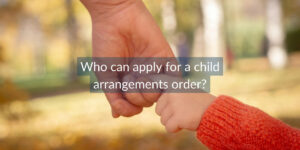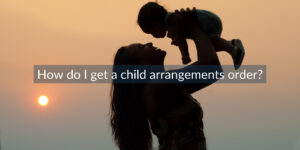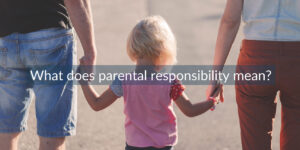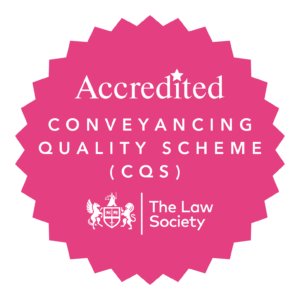Child arrangements if you divorce or separate | A complete guide

When family life is put under strain during a divorce or separation, it can be a challenging time. Separating parents or guardians will need to make decisions about how their children will be cared for, and if an agreement cannot be reached, a child arrangements order is a possible solution.
Here, our experienced family law team share a complete guide to child arrangements orders, including what they are, how to get one and what to expect.
You can also hear from our family solicitor Joeli Boxall on child arrangements in the video below.
Frequently asked questions
Click on the links below to jump to the different questions:
- What is a child arrangements order and what does it include?
- Who can apply for a child arrangements order?
- How do I get a child arrangements order?
- How long does it take?
- How much does a child arrangements order cost and how long does it last for?
- What happens if I have to go to court?
- Do my child’s wishes make a difference?
- Is it true that the court always favours the mother?
- What does parental responsibility mean?
- Does parental responsibility change after a divorce?
What is a child arrangements order and what does it include?

A child arrangements order is a court order that sets out who a child lives with, spends time with or otherwise has contact with. It is legally binding, so if the terms of the order are breached without good reason, enforcement action can follow.
A child arrangements order can, and often does, include quite prescriptive arrangements for a child; dictating what happens during term-time, school holidays and on special occasions, such as birthdays, Mother’s Day and Father’s Day. The order can specify handover times and locations, whether any third parties need to be present to supervise contact or help with handovers, as well as how the parties (the parents or guardians) are to communicate with one another about the children, for example, by way of a designated parenting app.
In certain cases, orders can also include solemn promises made by the parties to the court and each other (known as undertakings). These are things they promise to do or to refrain from doing something if it is deemed to be in the best interests of the child involved. For example, the parties may agree and undertake not to involve the child in adult discussions nor to put down the other parent while the child is present, if these allegations have been raised as a concern.
Who can apply for a child arrangements order?

The following people can apply for a child arrangements order without permission from the court:
- The child’s parent, guardian or special guardian
- Any person who has parental responsibility for the child and/or any person that has consent from the person with parental responsibility
- Anyone named in an existing child arrangements order as the person with whom the child lives and/or any person that has consent from the person named in a child arrangements order
- Any party to a marriage or civil partnership where the child is or was treated as a child of the family
- Anyone with whom the child has lived for a three-year period, provided the cohabitation did not begin more than five years prior to nor end more than three months before the application is made to court
- Anyone with the consent of the local authority if the child is in care
Applicants who don’t fit into one of these categories, such as grandparents or extended family members, would need to obtain permission from the court to apply for a child arrangements order.
How do I get a child arrangements order?

After a family breakdown, a child should be spending time with both parents, so long as it is safe to do so.
Most separated parents are able to agree on the arrangements for their child without the court’s involvement. In fact, the UK family court has a “no order principle”, which means that a child arrangements order should only be made if this would be better for the child than making no order at all.
In light of this, an application for a child arrangements order is only required when there is a parental dispute about how the child’s time with them should be shared. However, the court expects the parents to engage in non-court dispute resolution methods first, such as mediation or voluntary solicitor negotiations, before lodging an application with the court. The court has a wide discretion to make costs orders against those who make no attempt to resolve their dispute voluntarily.
If court assistance is needed, then either parent (or person permitted to seek contact with the child) must firstly complete a C100 application form and lodge this (usually online) selecting the court nearest to where the child lives. A court fee is payable (if you are not eligible for a fee remission) and once the application is issued, directions are made, and hearings are listed to progress the case to a conclusion. A child arrangements order will be made, either by consent or following a contested final hearing.
How long does it take?

The length of time that it takes to obtain a child arrangements order very much depends on the court dealing with the application and the complexities involved.
Cases where there are no safeguarding concerns, allegations of domestic abuse nor any expert involvement (other than a Cafcass (Children and Family Court Advisory and Support Service) officer completing the initial safeguarding letter), are likely to be concluded within 6–9 months. More complicated cases can take in the region of 12–18 months.
How much does a child arrangements order cost and how long does it last for?

The cost of obtaining a child arrangements order can be significant. Unless you are eligible for a fee remission (i.e. if you are on certain benefits or have a low income), a court fee of £263 is payable on lodging the C100 application.
After this, costs will vary in accordance with the amount of legal support and assistance required, the need for any expert evidence (i.e. a GP report, police disclosure or drug and alcohol testing) and the time it takes for an agreement or court mandated outcome to be reached.
If you are represented by a solicitor, legal fees can run into thousands of pounds depending on the complexity of the case and amount of court hearings involved. Your solicitor will give you a costs estimate at the outset of the work and keep you appraised on costs incurred and expected throughout to help you with budgeting. Each application is different and the likely costs can be quite wide ranging and impossible to fix, due to the various uncertainties, including the response of the other party. Your fee estimate will be bespoke and based on your specific circumstances.
Overall, court process can be both emotionally and financially expensive. It is usually in everyone’s best interests for alternative dispute resolution methods to be explored fully before there is any talk of going to court.
If a child arrangements order is made, then provisions will usually expire on the child’s 16th birthday. That is unless special consideration is given by the court, and expressly stated on the face of the order for it to apply up to age 18. A “lives with” order lasts until age 18 but in reality is difficult to enforce once a child turns 16, in some cases earlier, particularly if the child presents as mature and their wishes and feelings are strong. The court is often reluctant to even consider a child arrangements order application for a child who is approaching the age of 16, whether this is for contact or living arrangements.
What happens if I have to go to court?

The course that an application takes depends on the type of application, and whether there are allegations of harm made by one parent or the other, which the court feels the need to investigate.
If there are no such allegations and the application is for a child arrangements order (as is most common), then there will be three initial steps that the court will take:
- The court will send the application to Cafcass (the Children and Family Court Advisory and Support Service) to carry out preliminary safeguarding checks. Cafcass will produce a letter summing up their initial enquiries and views for the court to consider. Before it makes any order concerning children, the court will want to be satisfied that there are no safeguarding concerns. The process that the allocated Cafcass officer will go through in completing their letter includes speaking to both parents (usually by telephone) and then checking whether there are any records with social services and the police concerning the children and the parties to the application.
- The court will set a date for an initial hearing, which will either be a triage hearing (which takes place without the parties being present) or a FHDRA (First Hearing Dispute Resolution Appointment, which is attended by the parties). The court will consider the application and the safeguarding letter from Cafcass and then decide what next steps are required to progress the application. If it is a triage hearing, the court will draft the order that it has made with the appropriate directions and send this the parties. If it is a FHDRA, the parties will be present to liaise with the court about the directions and will also have an opportunity to agree interim contact arrangements, after which the directions order will be drafted by the parties’ solicitors or, if neither party is represented, by the court
- The court will then list a further hearing called a DRA (Dispute Resolution Appointment), which is attended by the parties with the aim that they will be able to agree on a final child arrangements order to be approved by the court or, if they still cannot agree on the arrangements, to attempt to narrow down the issues between them.
Once the DRA has taken place, if the parties have been unable to reach a final agreement, the court will then list the case for a final hearing and will decide whether any further evidence from the parties is required.
At the final hearing, both parties will normally give oral evidence, after which the court will make a decision as to what the final order should be.
Do my child’s wishes make a difference?

When considering whether to make a child arrangements order, the court must have regard to the ‘welfare checklist’ in section 1(3) of the Children Act 1989. The Act sets out a list of factors which the court needs to consider, one of which is “the ascertainable wishes and feelings of the child concerned (considered in the light of his age and understanding)”.
Therefore, the child’s wishes and feelings can bear influence to the order made, but this will be relevant to the child’s age and understanding. In practice, the views of a teenager will carry much more weight in the judge’s decision-making process than the views of a child under 10.
The child’s wishes and feelings are just one of several factors to be considered by the court and will not take precedence over anything else as they will need to be balanced against other factors. The weight to be attributed to the child’s wishes and feelings will be dependent on the court’s assessment of all other considerations such as:
the child’s physical, emotional and educational needs
- the likely effect on the child of any change in their circumstances
- the child’s age, sex, background and any characteristics of theirs which the court considers relevant
- any harm which the child has suffered or is at risk of suffering
- how capable each of the child’s parents, and any other person in relation to whom the court considers the question to be relevant, is of meeting their needs; and
- the range of powers available to the court under the Children Act 1989 in the proceedings in question.
In any case, it is important to avoid putting the responsibility of a decision on the child.
Is it true that the court always favours the mother?

This is not true. Before making an order concerning children, the court must consider the welfare checklist in section 1(3) of the Children Act 1989, which does not contain any presumption that children should live with their mother.
By and large, the courts reflect society where, so long as it is in their best interests, the care of children can – and should – be undertaken by either parent, ideally jointly.
What does parental responsibility mean?

Parental responsibility (PR) refers to the legal rights and responsibilities that a parent has for a child. The most obvious ones are to provide a home for a child and to care for them, but it can also include the right to be involved in certain decisions relating to a child like their name, education and medical treatment.
In practice, it means that everyone with PR must consult with each other before making an important decision in respect of a child. The decision, for example, to change a child’s name or school, must be agreed by everyone with PR. If it is not possible to reach an agreement, then a specific issue order or a prohibited steps order can be sought from the court to address the decision in question and either allow it or prevent it from happening.
Typically, it will be a child’s parents who have PR. The position can be complex but, as a general rule, the child’s birth mother will automatically have PR for the child. The child’s father or second legal parent will acquire PR for the child but only if they are married to or in a civil partnership with the child’s mother at the time of the child’s birth, or if they are named on the child’s birth certificate.
However, different rules apply for same sex couples. It is possible to subsequently acquire PR for a child by entering into a parental responsibility agreement with everyone who already has PR, or by obtaining a parental responsibility order from the court.
PR will also be granted automatically to a person with whom a child is to live under the terms of a child arrangements order, if that person doesn’t already have PR. This means that it is possible for someone who is not the child’s parent to acquire PR (e.g. a stepparent, grandparent or other carer for the child) and for there to be more than two people with PR for a child.
Adoption is another way of acquiring PR but eliminates any previous PR and requires full endorsement of the family court and local authority.
Does parental responsibility change after a divorce?

No – parental responsibility will continue irrespective of a divorce or separation of the child’s parents.
Only in very limited circumstances can a person’s PR be removed by the court. Adoption or where it can be demonstrated that it is in the child’s best interests for PR to be removed, which in practice is a very high bar to be met and a rare outcome indeed.
Need specialist legal advice on child arrangements, divorce or separation? Please get in touch with our family lawyers, who would be happy to help.
Contact usContact
Joeli Boxall (she/her) LLB (Hons), LLM
Associate, solicitor
 View profile
View profile

Related services
Share this article
The 'one lawyer two client' approach to divorce
In this video, hear from Willans’ head of family law, Sharon Giles as she introduces the ‘one lawyer two client’ approach to divorce, which allows divorcing couples to amicably end…
Sharon Giles LLB (Hons)
Partner

What is a child arrangements order?
What is a child arrangements order? In this video, our family solicitor Joeli Boxall explains what a child arrangements order is, when you should consider one and who can apply,…
Joeli Boxall LLB (Hons), LLM
Associate, solicitor

What is a prenuptial agreement?
What is a prenuptial agreement? In this video, family solicitor Kristie Silsby explains what a prenuptial agreement is, who should consider one, and what its benefits are. Kristie also discusses…
Kristie Silsby LLB (Hons)
Senior associate, solicitor










